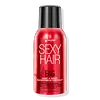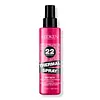What's inside
What's inside
 Key Ingredients
Key Ingredients

No key ingredients
 Benefits
Benefits

No benefits
 Concerns
Concerns

 Ingredients Side-by-side
Ingredients Side-by-side

Sd Alcohol 40-B
AstringentButane
Hydrofluorocarbon 152a
Octylacrylamide/Acrylates/Butylaminoethyl Methacrylate Copolymer
Ethoxydiglycol
HumectantSd Alcohol 40-B, Butane, Hydrofluorocarbon 152a, Octylacrylamide/Acrylates/Butylaminoethyl Methacrylate Copolymer, Ethoxydiglycol, Aminomethyl Propanol, Isobutane, Parfum, Benzyl Salicylate, Limonene, Eugenol, Hexyl Cinnamal, Linalool, PEG/PPG-17/18 Dimethicone, Acetyl Triethyl Citrate, Ethylhexyl Methoxycinnamate
Water
Skin ConditioningAlcohol Denat.
AntimicrobialVa/Crotonates/Vinyl Neodecanoate Copolymer
Octylacrylamide/Acrylates/Butylaminoethyl Methacrylate Copolymer
Crotonic Acid/Vinyl C8-12 Isoalkyl Esters/Va/Bis-Vinyldimethicone Crosspolymer
Cera Alba
EmollientAminomethyl Propanol
BufferingPhenoxyethanol
PreservativeParfum
MaskingPEG-30 Glyceryl Stearate
EmulsifyingXylose
HumectantHydrogenated Styrene/Butadiene Copolymer
Ethylhexylglycerin
Skin ConditioningBenzyl Salicylate
PerfumingBenzophenone-4
UV AbsorberBenzyl Alcohol
PerfumingLinalool
PerfumingHexyl Cinnamal
PerfumingMek
PerfumingDisodium Stearoyl Glutamate
CleansingVaccinium Macrocarpon Seed Oil
Skin Conditioning2-Oleamido-1,3-Octadecanediol
Skin ConditioningAlpha-Isomethyl Ionone
PerfumingCitronellol
PerfumingHydroxycitronellal
PerfumingLimonene
PerfumingBenzyl Benzoate
AntimicrobialTocopherol
AntioxidantWater, Alcohol Denat., Va/Crotonates/Vinyl Neodecanoate Copolymer, Octylacrylamide/Acrylates/Butylaminoethyl Methacrylate Copolymer, Crotonic Acid/Vinyl C8-12 Isoalkyl Esters/Va/Bis-Vinyldimethicone Crosspolymer, Cera Alba, Aminomethyl Propanol, Phenoxyethanol, Parfum, PEG-30 Glyceryl Stearate, Xylose, Hydrogenated Styrene/Butadiene Copolymer, Ethylhexylglycerin, Benzyl Salicylate, Benzophenone-4, Benzyl Alcohol, Linalool, Hexyl Cinnamal, Mek, Disodium Stearoyl Glutamate, Vaccinium Macrocarpon Seed Oil, 2-Oleamido-1,3-Octadecanediol, Alpha-Isomethyl Ionone, Citronellol, Hydroxycitronellal, Limonene, Benzyl Benzoate, Tocopherol
Ingredients Explained
These ingredients are found in both products.
Ingredients higher up in an ingredient list are typically present in a larger amount.
Aminomethyl Propanol is used to adjust the pH of products. It is also used as a base to create other organic compounds. Having a balanced pH is important for protecting your skin.
Aminomethyl propanol is safe to use in cosmetics up to 1%. It is soluble in water.
Benzyl Salicylate is a solvent and fragrance additive. It is an ester of benzyl alcohol and salicylic acid. This ingredient can be naturally found in some plants and plant extracts.
In fragrances, Benzyl Salicylate may be a solvent or a fragrance component. In synthetic musk scents, it is used as a solvent. For floral fragrances such as lilac and jasmine, it is used as a fragrance component. The natural scent of Benzyl Salicylate is described as "lightly-sweet, slightly balsamic".
While Benzyl Salicylate has been associated with contact dermatitis and allergies, emerging studies show it may not be caused by this ingredient alone.
However, this ingredient is often used with fragrances and other components that may cause allergies. It is still listed as a known allergen in the EU. We recommend speaking with a professional if you have concerns.
Another study from 2021 shows Benzyl Salicylate may have anti-inflammatory properties.
Learn more about Benzyl SalicylateHexyl Cinnamal is a fragrance ingredient with a similar scent to jasmine. It can be naturally found in chamomile essential oil.
This ingredient is a known EU allergen and may sensitize the skin. The EU requires this ingredient to be listed separately on an ingredients list.
Hexyl Cinnamal is not water soluble but is soluble in oils.
Learn more about Hexyl CinnamalLimonene is a fragrance that adds scent and taste to a formulation.
It's found in the peel oil of citrus fruits and other plants such as lavender and eucalyptus. The scent of limonene is generally described as "sweet citrus".
Limonene acts as an antioxidant, meaning it helps neutralize free radicals.
When exposed to air, oxidized limonene may sensitize the skin. Because of this, limonene is often avoided by people with sensitive skin.
The term 'fragrance' is not regulated in many countries. In many cases, it is up to the brand to define this term. For instance, many brands choose to label themselves as "fragrance-free" because they are not using synthetic fragrances. However, their products may still contain ingredients such as essential oils that are considered a fragrance.
Learn more about LimoneneLinalool is a fragrance and helps add scent to products. It's derived from common plants such as cinnamon, mint, citrus, and lavender.
Like Limonene, this ingredient oxidizes when exposed to air. Oxidized linalool can cause allergies and skin sensitivity.
This ingredient has a scent that is floral, spicy tropical, and citrus-like.
Learn more about LinaloolWe don't have a description for Octylacrylamide/Acrylates/Butylaminoethyl Methacrylate Copolymer yet.
Parfum is a catch-all term for an ingredient or more that is used to give a scent to products.
Also called "fragrance", this ingredient can be a blend of hundreds of chemicals or plant oils. This means every product with "fragrance" or "parfum" in the ingredients list is a different mixture.
For instance, Habanolide is a proprietary trade name for a specific aroma chemical. When used as a fragrance ingredient in cosmetics, most aroma chemicals fall under the broad labeling category of “FRAGRANCE” or “PARFUM” according to EU and US regulations.
The term 'parfum' or 'fragrance' is not regulated in many countries. In many cases, it is up to the brand to define this term.
For instance, many brands choose to label themselves as "fragrance-free" because they are not using synthetic fragrances. However, their products may still contain ingredients such as essential oils that are considered a fragrance by INCI standards.
One example is Calendula flower extract. Calendula is an essential oil that still imparts a scent or 'fragrance'.
Depending on the blend, the ingredients in the mixture can cause allergies and sensitivities on the skin. Some ingredients that are known EU allergens include linalool and citronellol.
Parfum can also be used to mask or cover an unpleasant scent.
The bottom line is: not all fragrances/parfum/ingredients are created equally. If you are worried about fragrances, we recommend taking a closer look at an ingredient. And of course, we always recommend speaking with a professional.
Learn more about Parfum